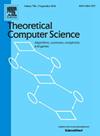分布式算法和lca中的采样和输出估计
IF 1
4区 计算机科学
Q3 COMPUTER SCIENCE, THEORY & METHODS
引用次数: 0
摘要
我们考虑了分布式消息传递模型和局部计算算法(LCA)模型。在这两种模型中,网络都用n顶点图G=(V,E)表示。重点研究了点着色、边着色、最大独立集(MIS)和最大匹配等标记问题。在分布式模型中,v的顶点并行执行计算,以便为g计算自己的解决方案。相反,在LCA模型中,探测在某些顶点上执行,以便在给定问题的解决方案中计算它们的标签。在这项工作中,我们研究了在算法终止之前估计算法产生的解的可能性。这种估计不仅允许解的大小近似,而且还允许在随机算法中早期检测故障。我们这样做是为了执行纠正程序。为此,我们提出了一种采样技术,其中采样中的标签与算法输出中的分布成比例分布。然而,采样运行时间明显小于现有算法。根据输入图的最大度Δ和树性a,我们得到了以下结果。对于采样点着色、边着色、最大匹配和MIS,我们的过程的运行时间为O(log (a) +log (n))。这大大改进了以前的采样技术,以前的采样技术会导致对最大度Δ的额外依赖,这可能比树性高得多,而且对n的依赖更大。不仅如此,我们还表明,我们的技术可以自然地扩展到幂图Gr,适用于任何常数整数r>;1,用于MIS和着色问题。我们在分布式模型中的采样技术为LCA模型中的估计提供了一个强大而通用的工具。在这种设置中,目标是通过尽可能少的顶点探测来估计给定问题的解决方案的大小。对于上述问题,我们实现了探测复杂度dO(log (a) +log (n))的估计,其中d=min(Δ,a⋅poly(log (n))。我们的结果也扩展到幂图的着色和MIS问题。本文章由计算机程序翻译,如有差异,请以英文原文为准。
Sampling and output estimation in distributed algorithms and LCAs
We consider the distributed message-passing model and the Local Computational Algorithms (LCA) model. In both models a network is represented by an n-vertex graph . We focus on labeling problems, such as vertex-coloring, edge-coloring, maximal independent set (MIS) and maximal matching. In the distributed model the vertices of v perform computations in parallel in order to compute their own solution for solving the problem for G. In contrast, in the LCA model probes are performed on certain vertices in order to compute their labels in a solution to a given problem. In this work we study the possibility of estimating a solution produced by an algorithm, much before the algorithm terminates. This estimation not only allows for size approximation of a solution, but also for early detection of failure in randomized algorithms. We do this such that a correcting procedure can be executed. To this end, we propose a sampling technique, in which the labels in the sampling are distributed proportionally to the distribution in the algorithm's output. However, the sampling running time is significantly smaller than that of the algorithm in hand.
We achieve the following results, in terms of the maximum degree Δ and the arboricity a of the input graph. The running time of our procedures is , for sampling vertex-coloring, edge-coloring, maximal matching and MIS. This significantly improves upon previous sampling techniques, which incur additional dependency on the maximum degree Δ that can be much higher than the arboricity, as well as more significant dependency on n. Not only that, we also show that our technique extends naturally for the power graph for any constant integer for the problems of MIS and coloring.
Our techniques for sampling in the distributed model provide a powerful and general tool for estimation in the LCA model. In this setting the goal is estimating the size of a solution to a given problem, by making as few vertex probes as possible. For the above-mentioned problems, we achieve estimations with probe complexity , where . Our results extend as well to power graphs for the coloring and MIS problems.
求助全文
通过发布文献求助,成功后即可免费获取论文全文。
去求助
来源期刊

Theoretical Computer Science
工程技术-计算机:理论方法
CiteScore
2.60
自引率
18.20%
发文量
471
审稿时长
12.6 months
期刊介绍:
Theoretical Computer Science is mathematical and abstract in spirit, but it derives its motivation from practical and everyday computation. Its aim is to understand the nature of computation and, as a consequence of this understanding, provide more efficient methodologies. All papers introducing or studying mathematical, logic and formal concepts and methods are welcome, provided that their motivation is clearly drawn from the field of computing.
 求助内容:
求助内容: 应助结果提醒方式:
应助结果提醒方式:


